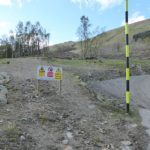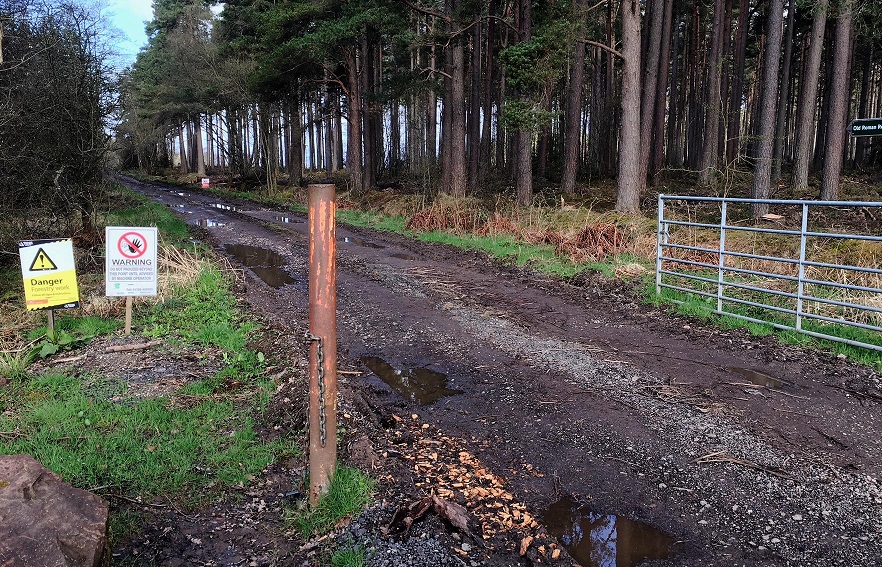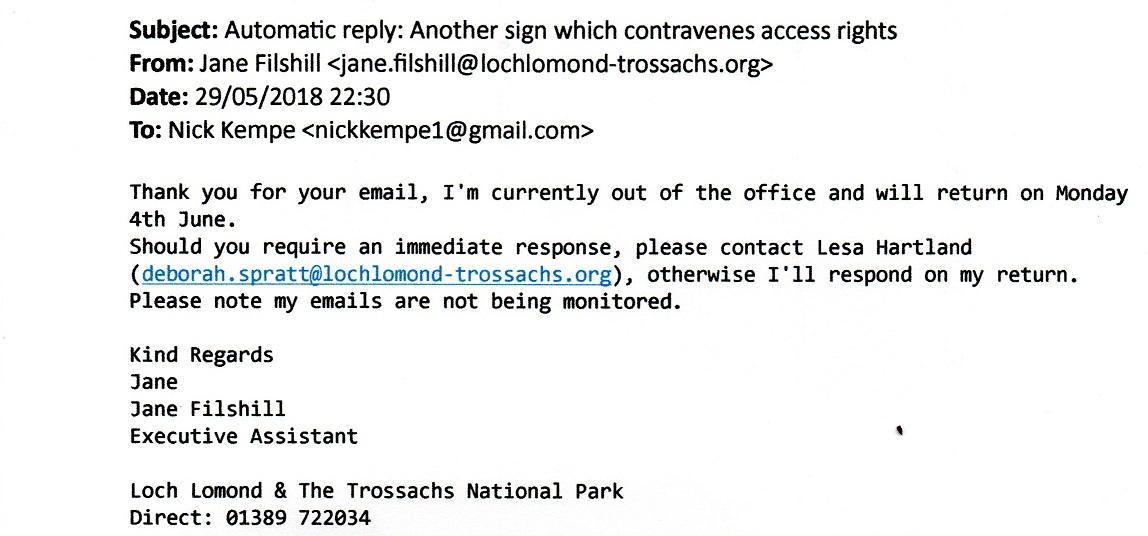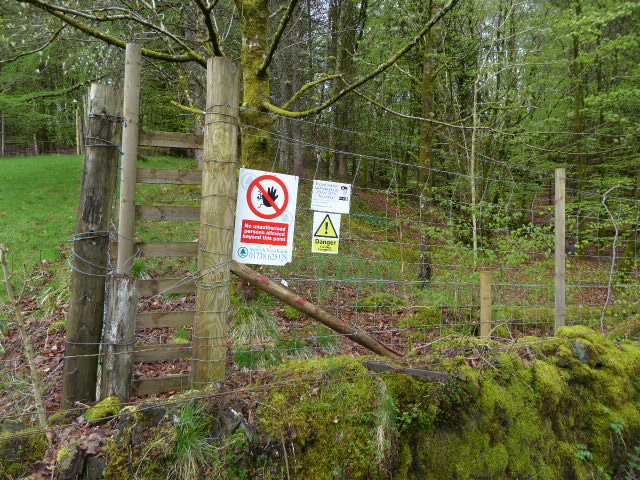Tilhill Forestry is changing its approach to access

A few days after my post on forestry industry signs and access rights, I was contacted by Kirsty Adams, Head of Health and Safety at Tilhill Forestry asking to speak because “Tilhill Forestry are currently running a public awareness of safety in the forest project and one of the key objectives is to improve how we communicate with the public when we are harvesting areas that have high public use”. Meantime Ramblers Scotland had put me in touch with one of their activists who had been trying to get local Tilhill Managers to remove inappropriate signs near Findo Gask in Perth & Kinross.

These signs were located at the star of a core path – core paths that are seen as being of particular importance for recreation and travel – and the issues were very similar to those I had highlighted in my post with unnecessary blanket restrictions. I put Kirsty in touch with the local activist.
The outcome of Kirsty’s intervention is that both the Balquidder and Findo Gask signs will be coming down! A fantastic result but one that would not have happened if Kirsty and other people working at Tilhill had not already been reviewing how they manage access rights – not just in Scotland but across the UK.
What Kirsty explained to me on the phone is that while Tilhill has to use certain health and safety signs around forest operations – and rightly so, forest machinery can be very dangerous – she had identified a number of issues (my summary):
- that warning signs often cover “ten times” – her words – the area needed
- that warning signs are often positioned in the wrong place
- that warning signs are not taken down when operations have ceased (for the day, weekend etc)
- that there have been failures to suggest alternative routes
The solutions Tilhill have identified to address these issues are, I believe, completely in accord with the guidance that has been agreed under the Scottish Outdoor Access Code Forestry good practice FCPN104.
Tilhill though is going further than this. First, they are trying to apply a similar approach in England – where at present there is no general formal right of access to forests. Second, they are looking to develop new solutions to manage risks. One of these is to see if they could develop a system where the warning sign gives a phone number for walkers to alert the machine operators that they are approaching so the machinery could stop to let them by. This apparently now is much more feasible with operators able to use hands free phones that can be heard above the noise. Brilliant!
Equally commendable is that Kirsty Adams has said she is committed to improving Tilhill’s use of access signage across Scotland and would welcome reports and photos of any inappropriate signs kirsty.adams@tilhill.com. In other words if people report inappropriate signs, as I have been urging on parkswatch, in the case of Tilhill you are almost guaranteed a positive response. (While Parkswatch is focussed on National Parks, if there are other examples that result from this I would be happy to give them publicity).
Seafield Estates’ response to inappropriate access signs – an apology
Tilhill is not the only private forestry operation who has responded positively following posts on parkswatch. At the end of last year, following a post on forestry tracks and access at Kinveachy Estate (see here), the Seafield Estate manager contacted me. We had a very interesting and productive discussion on the phone which I had been meaning to cover ever since. He started by agreeing that the no access signs at Kinveachy were in the wrong place and were up at times when no warnings were needed and agreed to speak to their contractors about this. Openness rather than defensiveness.
The Manager also told me about some of the challenges of managing access and forestry operations. The hillside above the A9 where the forest operations were taking place is popular with mountain bikers and in the past mountain bikers have descended very fast close to heavy machinery without apparently any understanding of the risks. One of the outcomes was the Estate had had meeting with mountain bike representatives to try and address the issues. I have not been able to check this but believe its the right way to deal with health and safety issues: engage with the public about solutions. So, another commendably open forestry manager who cares about access.
Our National Parks and forestry industry access signs
The credit for removal of these inappropriate forestry access signs – at Balquidder, Findo Gask or at Kinveachy is only in part due them being reported by activists: the other side of the equation is that there are some great people working in the private forestry industry who have been thinking deeply about the issues of how to manage forest operations within the context of access rights and are prepared to respond. That is most welcome but where are our National Parks in all of this?
Our National Parks are Access Authorities which are supposed to exemplify best practice – part of the reason why they, unlike other Access Authorities, have a dedicated place on the National Access Forum. So what have they been doing to address the issue of inappropriate forestry signage? Why does it appear easier for individuals, who have no power as such, communicating directly with the forestry industry to address these issues rather our National Parks with their statutory powers?
In the case of the Cairngorms National Park Authority the Seafield Manager did tell me they had had support from the CNPA access team in the past and, while this appeared to have got lost in staff changes, in the case of Kinveachy they were not aware of the signs. Here is the response I received from Murray Ferguson, the senior manager then responsible:
Thanks for raising that with us. We log all such issues raised with us as an outdoor access authority. It is really important that people do so when they see things that concern them – I saw a good piece about the importance of reporting issues on WalkHighland blog recently.
In the case of the Loch Lomond and Trossachs National Park Authority, however, there is now evidence to suggest that the access team is being PREVENTED from even recording access issues, including forestry industry signs. When I sent an email to the LLTNPA access team trying to report the sign at Balquhidder on 29th May, I got an out of office reply, not from the access team but from the Personal Assistant who supports the Chief Executive:

It appears my email are being redirected from the access team so they all now go through the LLTNPA Chief Executive, Gordon Watson. Unlike the CNPA Mr Watson has failed to acknowledge my reporting of this problem and I and have doubts that the Access Team have ever been told about it. I say this because I have had no acknowledgement of the Forestry Commission Scotland no access signs and barriers I reported a week later – following reports from a reader – at Cruach Tairbeart (see here). If the emails have been passed on to access staff it appears they are banned from providing any information about what they are doing. This situation is not their fault but the responsibility of the Chief Executive and is a complete about turn from the situation six months ago when, after the intervention of the Convener James Stuart they were allowed, briefly, to communicate directly.
The wider issue here is not just about how the LLTNPA try to control and victimise people who raise legitimate issues with them, its that the LLTNPA has been aware of problems created by the private forest industry for some time – as per the sign below on the Invertrossachs Rd, CCTV warnings and all – which I reported over a year ago.

In my recent posts I called on the LLTNPA senior management to allow their access team to negotiate more strategically with forest operators in the National Park to remove these signs and follow best practice. The evidence strongly suggests that their Senior Management Team is interfering in their ability to do so. That is not to say the LLTNPA access team is doing nothing – I will cover some positive progress elsewhere in another post – but what they can do and what they can tell the public is being closely controlled.
